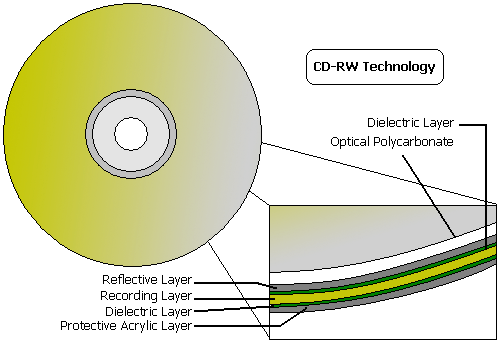 |
|
|
|
In the Forums... |
Posted: May 13, 2000 Written by: Tuan "Solace" Nguyen CD-R We donít all have industrial CD presses in our homes, but that doesnít mean we canít make our own CDs. Enter the world of CD-R (CD Recordable).  On the top side of the disc, you have the protective acrylic layer that prevents scratches to the recording material. Then you have the actual recording layer -- the dye layer, where the recording laser burns data pits and lands into the polymer dye. The laser burns non-translucent data pits which absorb light that would normally reflect back the read laser. The parts that are not burnt are the pits. The reflective layer is the layer which reflects the read laser beam back to the optical sensor which translates the pulses into 1ís and 0ís. CD-RW There is one drawback to CD-R technology, itís only recordable once, and itís permanent, you cannot record over existing data. This is where CD-RW (CD ReWritable) comes to the rescue.  CD-RW uses a technology called phase-change which create pits and grooves by changing certain portions of the recording layer from reflecting to absorbing light. The dielectric layer is an insulation layer that isolates and quickly cools the phase-change recording process. While this is happening, the CD-RW laser heats the polycrystalline surface of the recording layer to change its state (phase-change). Data is recorded as amorphous (shapeless) pits and lands. CD-RW is less reflective than CD-R and therefore are not readable on older generation CD-ROM drives. Newer drives use the multi-read standard enabling them to automatically adjust the laser gain. The advantage of using CD-RW over CD-R is the ability to rewrite about 1000 times on the same disc. However, current writes speeds of RW discs are relatively slow to that of CD-R. While CD-R write speeds have reached 12x, RW stays at 4x. DVD Short for Digital Versatile Disc or Digital Video Disc (depending on which side of the industry youíre on), DVDs are designed to supplement and eventually replace the CD. "What is the difference? A DVD and a CD both look the same to me!" Well physically, in size, they are the same but microscopically they are not. The pits and lands on a DVD disc are much smaller than those on a CD, and they are also more closely packed.  CD Lands and Pits VS. DVD Lands and Pits Above is a diagram comparing the pits and lands between a CD and a DVD. More information can be packed on the DVD because the size of each bit is physically smaller than a CD. Because of this, the read laser also needs to be smaller. A read laser that reads CDs is red. Red has a longer and larger wavelength, thus, making the beam larger. DVDs need something more precise to be read. A blue laser is used for DVDs because the blue light wavelength is much shorter and thinner, thus, giving a more precise beam. |
||
|
| |||
|---|---|---|---|